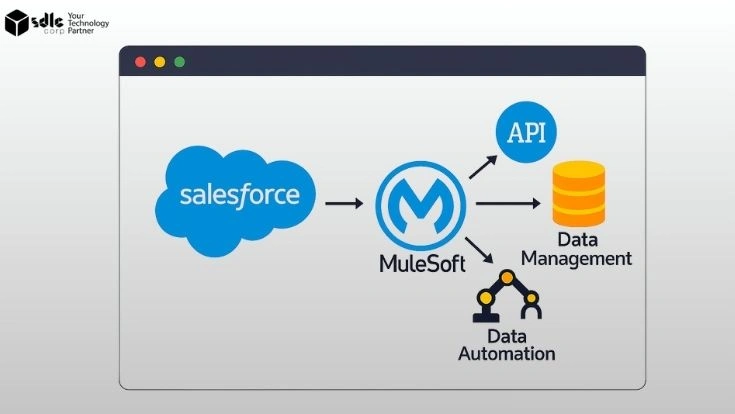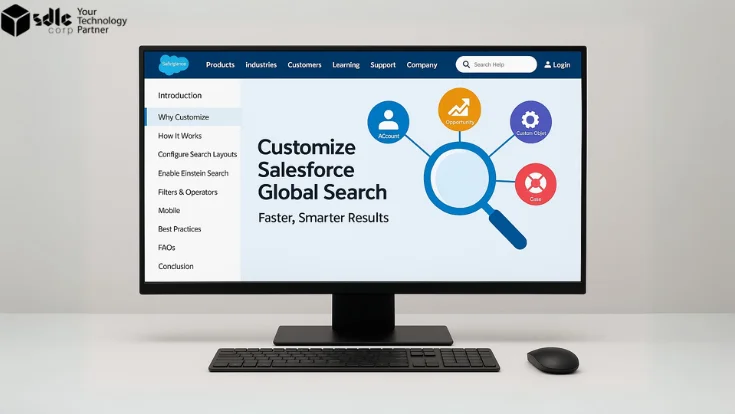Introduction
Custom Metadata Types in Salesforce (CMDTs) are one of the most powerful tools for building scalable, configurable applications. Unlike custom settings, CMDTs are deployable, packageable, and version-controlled, making them ideal for enterprise-grade Salesforce projects.
They allow you to define reusable configurations, business rules, feature toggles, and integration endpoints without hardcoding values. This guide explains what Custom Metadata Types are, how they differ from Custom Settings, their key use cases, setup process, and best practices.
What Are Custom Metadata Types in Salesforce?
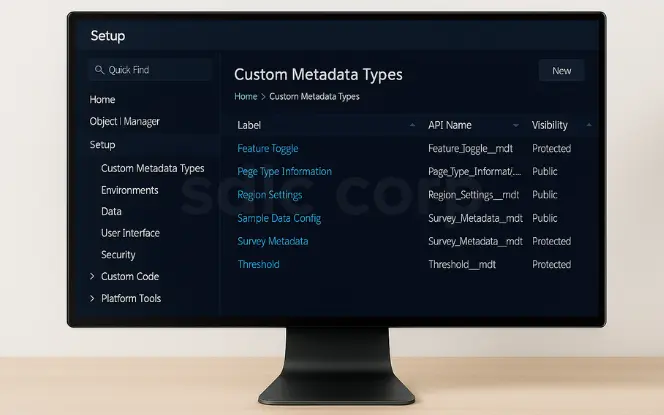
Custom Metadata Types (suffix __mdt) let you define application configuration as metadata. Both the type and its records can be deployed across environments.
They support fields, validation rules, and relationships.
CMDT records are cached at runtime, so retrieving them doesn’t count against SOQL governor limits.
They integrate seamlessly with Apex, Flow, and formulas, enabling both declarative and programmatic use.
Related reading: Salesforce Validation Rules Examples You Can Copy
Custom Metadata Types vs Custom Settings
| Feature | Custom Metadata Types (CMDTs) | Custom Settings |
|---|---|---|
| Deployable with records | Yes | No |
| Packageable for AppExchange | Yes | No |
| Supports validation & formulas | Yes | No |
| Cached (no SOQL needed) | Yes | No |
| Best for | Reusable configuration | Org-specific values |
For most Salesforce configuration metadata, CMDTs are the better option.
Related reading: Salesforce Record-Level Security
Key Use Cases of Custom Metadata Types
Custom Metadata Types in Salesforce go far beyond simple configuration. They allow admins and developers to store business rules, reference data, and environment-specific settings directly as metadata. This means values are not only reusable but also deployable across sandboxes, staging, and production environments without manual re-entry.
Whether you’re managing feature toggles, lookup tables, integration endpoints, or security rules, CMDTs provide a scalable and version-controlled solution that reduces hardcoding and simplifies maintenance.
1. Configuration & Feature Management
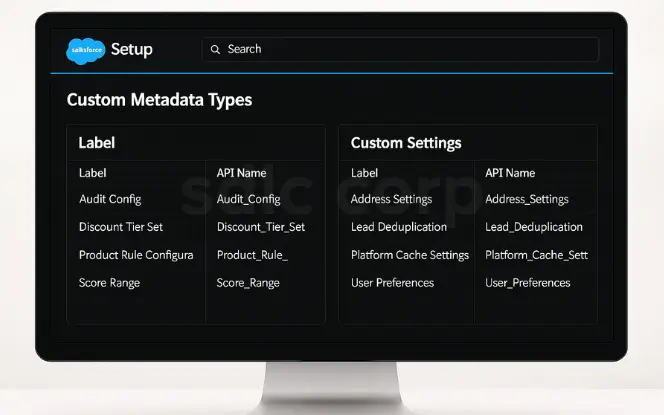
CMDTs are perfect for feature toggles and environment-specific rules. Instead of editing Apex, you switch features on/off through CMDT records.
Related reading: Salesforce Approval Process: Step-by-Step Guide
2. Data Mappings & Lookup Tables
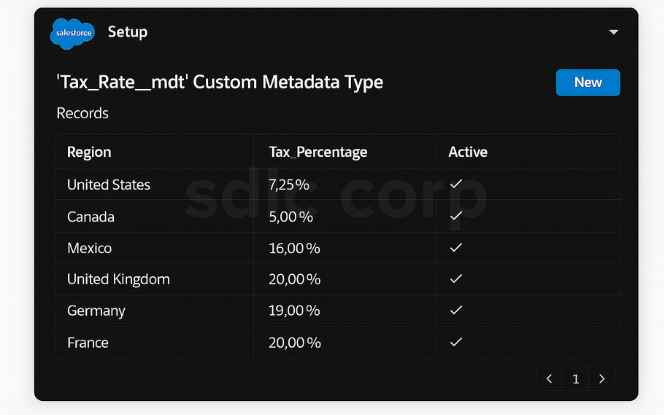
CMDTs can store reference data such as tax brackets, endpoint URLs, or region codes. This makes them reusable across orgs.
3. Integration with Apex, Flows, and Formulas
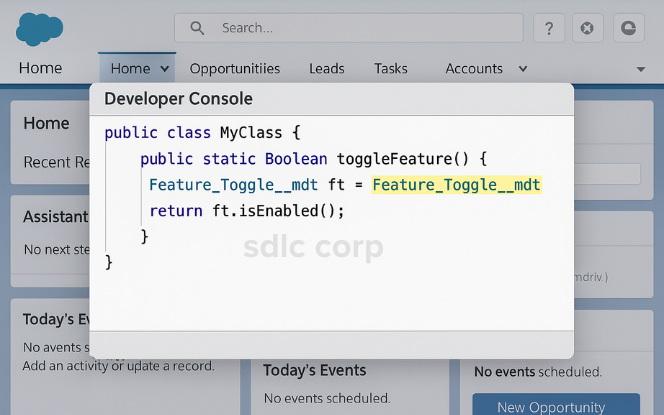
Apex: Access with
getAll()andgetInstance().Flows: Reference CMDT values in automation.
Formulas: Use
$CustomMetadatato replace hardcoded values.
Related reading:
4. Business Rules & Defaults
Store thresholds, limits, and default values in CMDTs for maintainable logic across orgs.
Related reading: Dynamic Forms vs Page Layouts: What to Use When
Step-by-Step Setup: Creating Custom Metadata Types
The advantages of AI in HR go beyond time savings. They shape strategy and workforce experience.
Step 1 — Create the CMDT
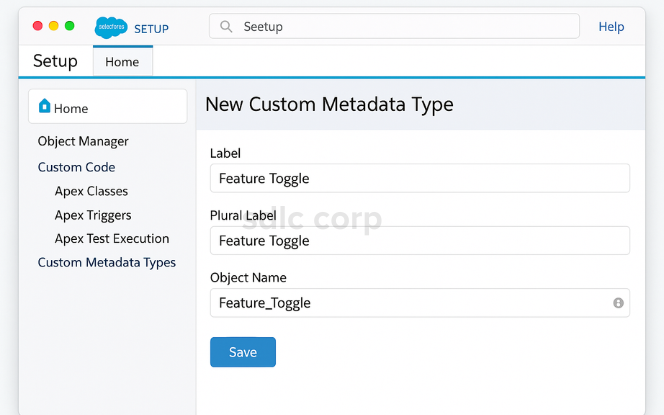
Go to Setup → Custom Metadata Types → New.
Enter Label:
Feature Toggle.Object Name:
Feature_Toggle.Save.
Step 2 — Add Fields
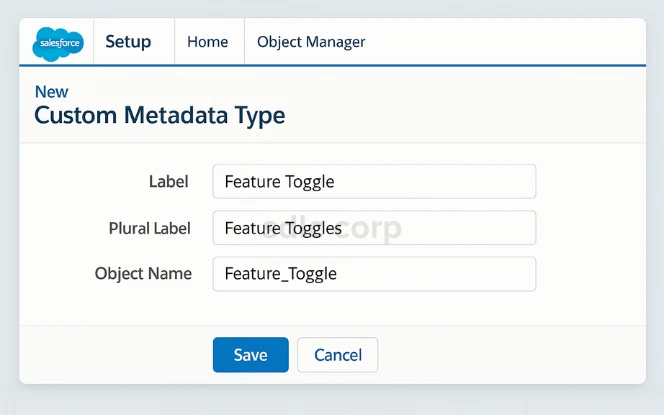
Add custom fields such as:
Feature_Key__c(Text)Is_Enabled__c(Checkbox)Description__c(Text Area)
Step 3 — Set Visibility
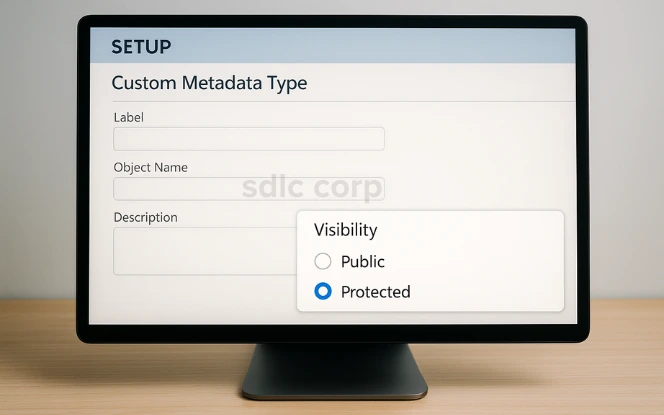
Public: Usable across subscriber orgs.
Protected: Restricted to package namespace.
Step 4 — Create Records
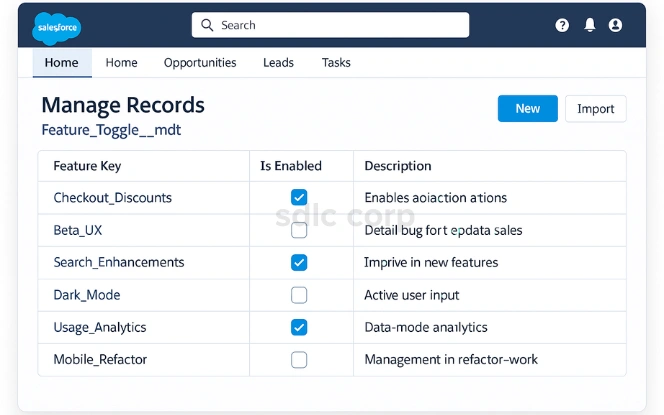
Click Manage Records and add entries like:
Checkout_Discounts→Is_Enabled = TRUEBeta_UX→Is_Enabled = FALSE
Step 5 — Use CMDT in Apex
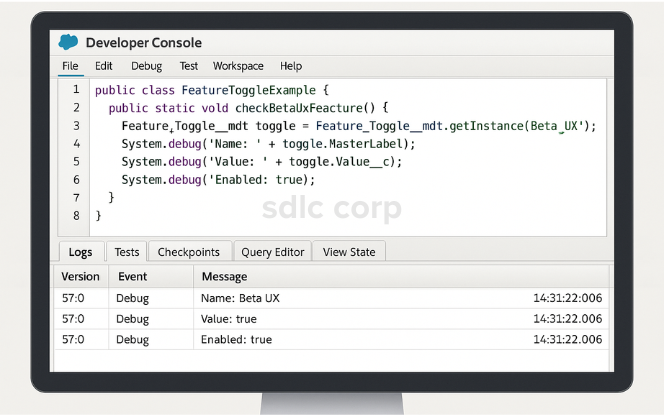
CMDTs can be accessed in Apex without SOQL (faster, doesn’t consume governor limits).
Example 1: Single record
Feature_Toggle__mdt betaUX = Feature_Toggle__mdt.getInstance('Beta_UX'); if (betaUX != null && betaUX.Is_Enabled__c) {
System.debug('Beta UX feature is enabled!');
} else {
System.debug('Beta UX feature is disabled.');
} Example 2: All records
Map<String, Feature_Toggle__mdt> toggles = Feature_Toggle__mdt.getAll(); if (toggles.get('Checkout_Discounts') != null &&
toggles.get('Checkout_Discounts').Is_Enabled__c) {
System.debug('Checkout Discounts are active!');
} Example 3: SOQL (for long text fields)
List<Feature_Toggle__mdt> toggles = [
SELECT DeveloperName, Feature_Key__c, Is_Enabled__c, Description__c
FROM Feature_Toggle__mdt
]; for (Feature_Toggle__mdt toggle : toggles) {
System.debug('Feature: ' + toggle.DeveloperName +
' Enabled: ' + toggle.Is_Enabled__c);
}Step 6 — Use CMDT in Formulas & Flows
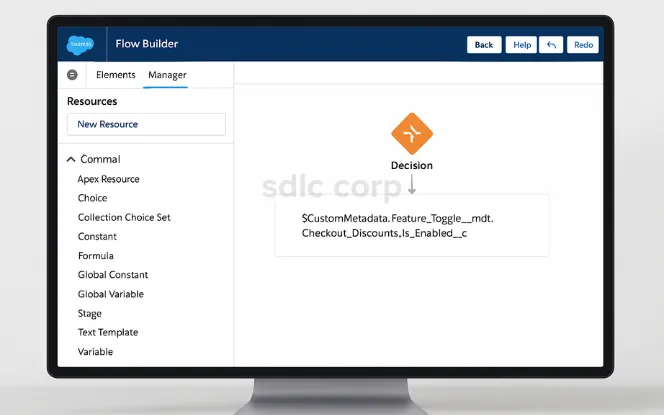
Formula Example
$CustomMetadata.Feature_Toggle__mdt.Checkout_Discounts.Is_Enabled__c 👉 Useful for validation rules or default values.
Flow Example
Create a Flow.
Add a Decision Element.
Reference
$CustomMetadata.Feature_Toggle__mdt.Choose
Is_Enabled__cfor decision logic.
Flows can now change behavior based on metadata.
Step 7 — Test CMDTs in Apex
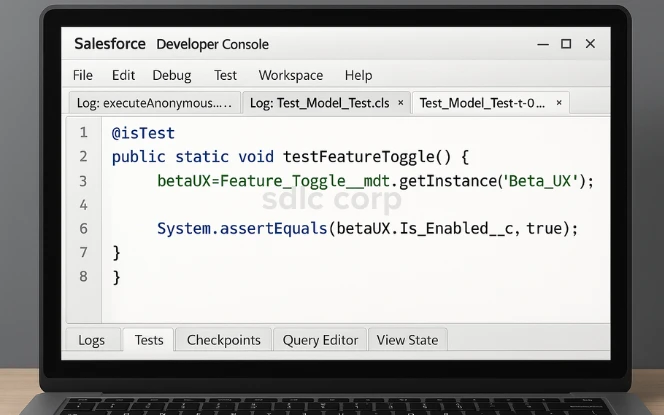
CMDTs are available by default in tests.
@isTest
private class FeatureToggleTest {
@isTest static void testBetaUXToggle() {
Feature_Toggle__mdt betaUX = Feature_Toggle__mdt.getInstance('Beta_UX');
System.assertEquals(false, betaUX.Is_Enabled__c,
'Beta UX should be disabled by default');
}
}Step 8 — Deploy CMDTs Across Environments
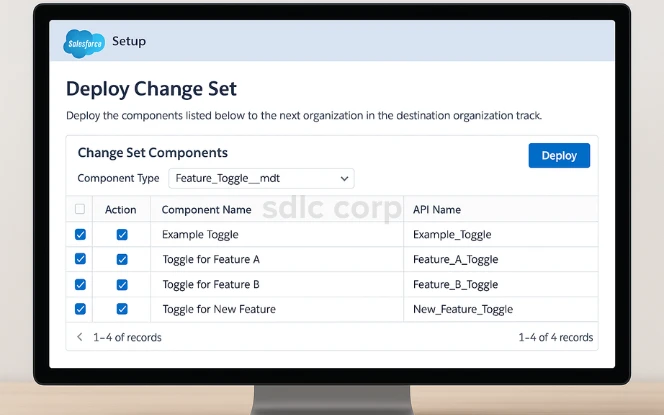
Change Sets → point-and-click migration.
Salesforce CLI (sfdx) → for CI/CD pipelines.
Unlocked Packages → best for large teams.
Always deploy CMDT + records together.
Related reading: Salesforce Sandbox Refresh Best Practices for 2025
Best Practices for Custom Metadata Types
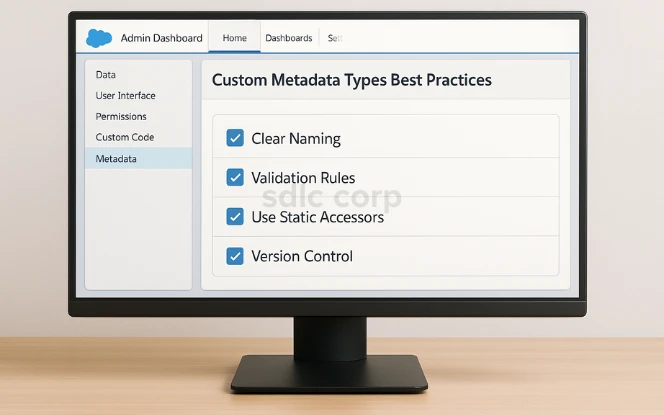
Name fields clearly → e.g.,
Feature_Key__c.Keep CMDTs lightweight → only store values needing deployment.
Use static accessors in Apex → avoid unnecessary queries.
Add validation rules → prevent incorrect metadata.
Version-control metadata → commit CMDTs to Git with other metadata.
Related reading: Salesforce Sandbox Refresh Best Practices for 2025
Benefits of Using Custom Metadata Types
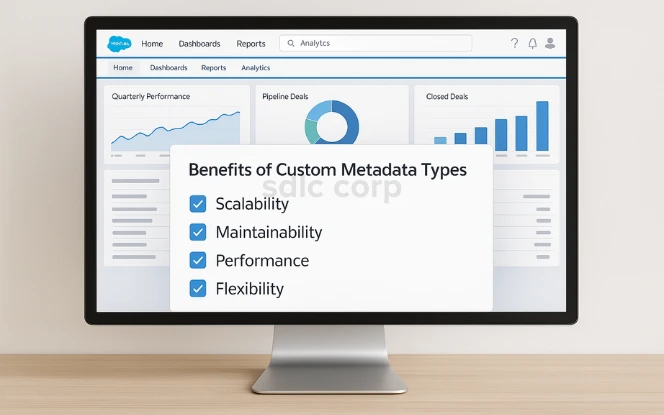
Scalability → works across orgs and packages.
Maintainability → avoids hardcoding.
Performance → cached, no SOQL needed.
Flexibility → usable in Apex, Flows, Formulas.
Conclusion
Salesforce Custom Metadata Types give developers and admins a powerful way to manage configurations declaratively. They reduce code maintenance, improve scalability, and help enforce governance.
For feature toggles, mappings, integration settings, and reusable business rules, CMDTs should be your go-to choice.
Related reading: Understanding Salesforce Page Layouts vs Dynamic Forms
FAQs
Q1: What are Custom Metadata Types in Salesforce?
Custom Metadata Types (CMDTs) are metadata objects (__mdt) used to store configuration as metadata. They help developers and admins manage reusable values, rules, and settings that can be deployed across orgs.
Q2: How do Custom Metadata Types differ from Custom Settings?
CMDTs are deployable with records, packageable, and support validation rules and formulas. Custom Settings are limited to org-specific data, making CMDTs the better choice for scalable configuration.
Q3: What are the main use cases of Custom Metadata Types?
CMDTs are best for feature toggles, lookup tables, integration endpoints, business rules, and environment-specific settings. They remove hardcoding and improve governance.
Q4: Can I use Custom Metadata Types in Apex code?
Yes. CMDTs can be accessed using getAll() or getInstance() methods in Apex without consuming SOQL queries. For long text fields, you can use SOQL queries on __mdt objects.
Q5: How can Custom Metadata Types be used in Flows and Formulas?
CMDTs can be referenced in Flows via Decision Elements and in formulas using $CustomMetadata. This allows admins to configure automation without hardcoding values.
Q6: Are CMDTs available in all Salesforce editions?
Yes. Custom Metadata Types are available in Enterprise, Performance, Unlimited, and Developer editions.
Q7: Do CMDTs count against SOQL governor limits?
Yes. Custom Metadata Types are available in Enterprise, Performance, Unlimited, and Developer editions.



